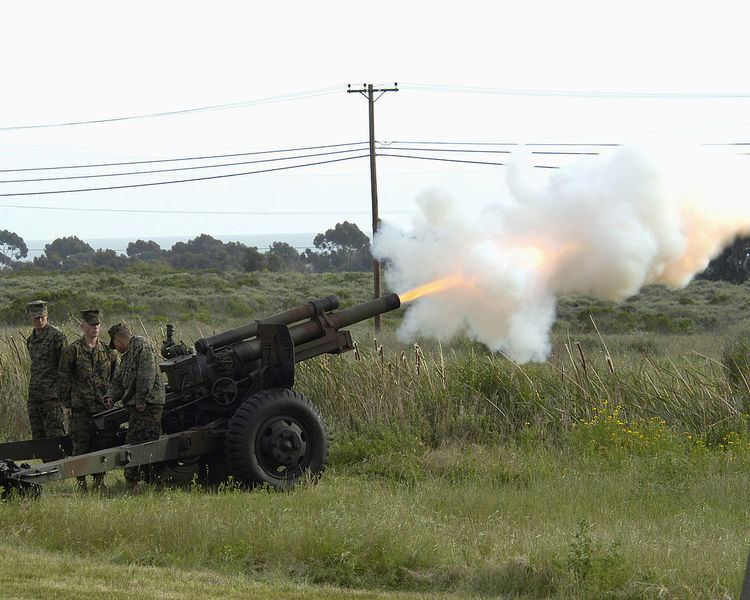Produced 1941–1953 | Place of origin United States | |
 | ||
Wars World War IIKorean WarFirst Indochina WarVietnam WarInsurgency in the Philippines | ||
The 105 mm M2A1 (M101A1) howitzer was a howitzer developed and used by the United States. It was the standard U.S. light field howitzer in World War II and saw action in both the European and Pacific theaters. Entering production in 1941, it quickly gained a reputation for accuracy and a powerful punch. The M101A1 fired 105-millimetre (4.1 in) high explosive (HE) semi-fixed ammunition and had a range of 11,270 metres (12,330 yd), making it suitable for supporting infantry.
Contents
All of these qualities of the weapon, along with its widespread production, led to its adoption by many countries after the war. Its ammunition type also became the standard for many foreign countries' later models.
History
During the Second World War, U.S. artillery regiments consisted of an HQ detachment, one 155mm artillery battalion, and three 105mm artillery battalions. Both the 155mm and 105mm battalions had twelve guns each, divided into three batteries of four guns. That gave each regiment a total of twelve 155mm howitzers, and thirty six 105mm howitzers. With an HE M1 shell fired at 9000 meters, the probable error in range was 41 meters, while the probable error in line was 10 meters.
The U.S. military artillery designation system was changed in 1962, redesignating the 105mm M2A1 howitzer the M101A1. The gun continued to see service in the Korean and Vietnam Wars. Though a similar model, the M102 howitzer, shared the same roles in battle, it never fully replaced the M101A1. Today, the M101A1 has been retired by the U.S. military, though it continues to see service with many other countries. By the end of the Second World War, 8,536 105mm towed howitzers had been built and post-war production continued at Rock Island Arsenal until 1953, by which time 10,202 had been built.
The Canadian Forces continued to use the M2A1 as the C2 Howitzer until 1997, when a modification was made to extend its service life; it is now designated the C3. The changes include a longer barrel, a muzzle brake, reinforced trails and the removal of shield flaps. It remains the standard light howitzer of Canadian Forces Reserve units. The C3 is used by Reserve units in Glacier National Park in British Columbia as a means of avalanche control. In addition, the M101 has found a second use in the U.S. as an avalanche control gun, supervised by the US Forest Service.
France and the State of Vietnam used M2A1 howitzers during the First Indochina War, as did the Viet Minh guerilla forces, who were supplied with at least 24 by the People's Republic of China, along with other captured American artillery pieces and mortars formerly operated by the Nationalist Chinese forces (the Kuomintang military). Today upgraded M2A1 howitzers (some of which have been mounted on trucks and employed as self-propelled artillery) are still being used by the People's Army of Vietnam (the VPA). It continues to remain as the primary tactical field-howitzer of the VPA.
A number of M2/M101 howitzers were used by the Socialist Federal Republic of Yugoslavia and approximately 50 were inherited by Croatia, of which four are still in use for training with the Croatian army.
M2 Howitzers are still in limited service in the Australian Army Reserve, but are being replaced with 81-millimetre (3.2 in) mortars with an emphasis on the retention of indirect fire support skills. In regular service they were replaced by the 105mm L119 Hamel gun and the 155-millimetre (6.1 in) M198 howitzers.
Two M2 howitzers (1942) are still employed in providing the gun salute at Kristiansten Fortress, in Trondheim, Norway. M101/M2 is one of three approved salute guns in the Norwegian armed forces, and have been reduced to a caliber of 75 millimetres (3.0 in) for this purpose. They are used for gun salute also at Rena and Setermoen.
Variants
Gun variants:
Carriage variants:
Self-propelled mounts
Ammunition
The gun fired semi-fixed ammunition, with 105mm Cartridge Case M14. The propelling charge consisted of a base charge and six increments, forming seven charges from 1 (the smallest) to 7 (the largest). Use of M1 HE rounds prepared for the 105mm howitzer M3 (same projectile and cartridge, but different propelling charge) was authorized.
HEAT M67 Shell was originally designed as fixed round, with Cartridge Case M14 type II. It was later changed to semi-fixed type with the standard cartridge, but with non-adjustable propelling charge. For blank ammunition, a shorter Cartridge Case M15 with black powder charge was used.
